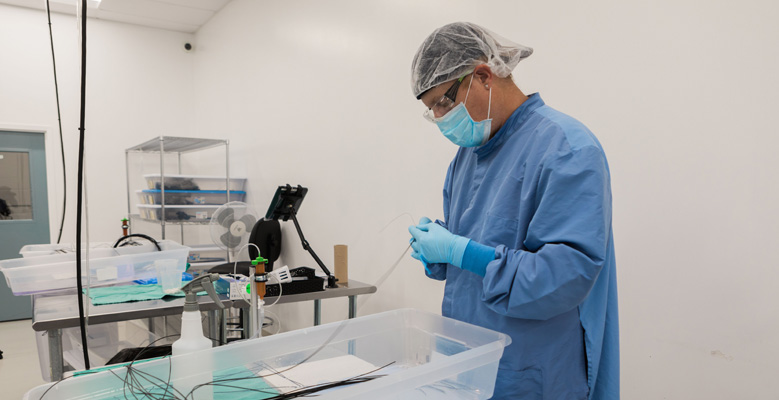Medical imaging has come a long way, and IVUS catheters are playing an increasingly important role in this revolution. Intravascular ultrasound (IVUS) catheters provide real-time, high-resolution imaging from inside blood vessels, offering a detailed view of arterial health. Unlike traditional angiography, which gives a flat, two-dimensional outline of vessels, IVUS creates a 3D, cross-sectional image, helping doctors detect plaque buildup, assess blockages, and guide interventions with pinpoint accuracy.
As IVUS technology evolves, innovations such as reprocessed IVUS catheters are making this advanced imaging technique more cost-effective and sustainable, helping healthcare providers reduce expenses without compromising quality.

How IVUS Catheters Work
An IVUS catheter is a thin, flexible device with a small-scale ultrasound transducer at its tip. When inserted into an artery—typically through the femoral or radial artery—the transducer emits high-frequency sound waves. These waves bounce off the vessel walls and return as echoes, which are then converted into real-time, detailed images of the artery’s interior.
Why This Matters
Unlike traditional imaging techniques that only capture external vessel structures, IVUS provides an internal, high-resolution view, helping physicians:
- Identify narrowed arteries and plaque buildup.
- Assess stent placement and artery expansion after treatment.
- Reduce guesswork in complex vascular procedures.
With modern advancements like 3D imaging and automated measurements, IVUS is more precise than ever, enhancing efficiency and precision in diagnostics.
Key Benefits of IVUS Catheters
1. Imaging Precision
With high-resolution visuals, IVUS gives a clearer picture of plaque composition, arterial walls, and blood flow patterns, supporting diagnostic accuracy.
2. Real-Time Procedural Guidance
During procedures like angioplasty or stent placement, IVUS helps physicians monitor the process in real time, helping to provide procedural insights and assist in complication management.
3. Minimally Invasive Approach
In comparison to non-minimally invasive procedures, IVUS is performed with a thin, flexible catheter, requiring only small incision and local anesthesia. This means:
- Potentially shorter recovery times compared to non-minimally invasive procedures
- Less discomfort for patients compared to traditional surgical interventions
- Lower risk of post-procedure complications in specific cases
4. Cost-Effective & Sustainable Options
Healthcare providers looking to reduce costs without sacrificing imaging quality are turning to reprocessed IVUS catheters. These devices undergo an FDA-cleared reprocessing cycle and quality control that ensures they are substantially equivalent in safety and quality to new catheters—at a fraction of the cost.
Additionally, reprocessed IVUS catheters reduce medical waste, supporting sustainability goals in modern healthcare.
The Evolution of IVUS Technology
Since its introduction in the late 1980s, IVUS has seen significant advancements:
- From Analog to Digital – Early IVUS systems had low resolution and bulky equipment. Today’s digital imaging is sharper, faster, and more detailed.
- 3D Imaging & AI Integration – Advanced IVUS systems now offer 3D views of arteries, with AI-powered lesion detection to assist vascular surgeons.
- Multi-Modality Imaging – IVUS is now used alongside Optical Coherence Tomography (OCT) and CT scans, offering a more complete vascular assessment.
- Sustainable Innovations – The rise of reprocessed IVUS catheters allows hospitals to extend their budgets while reducing environmental impact.
Where IVUS Is Making an Impact
1. Cardiology
IVUS is a valuable tool for diagnosing coronary artery disease (CAD). It helps doctors assess atherosclerosis severity, guide stent placement with higher accuracy, and reduce the need for unnecessary interventions1.
2. Peripheral Vascular Interventions
For patients with Peripheral Artery Disease (PAD), IVUS is a valuable tool for assessing blockages and optimizing treatment strategies2.
3. Investigational Applications
Some emerging research is exploring the potential for IVUS to evaluate tumor-associated blood vessels. While not-FDA cleared for oncology use, these studies may help inform future innovations or clinical applications in other specialties.
Challenges & Considerations
- Technical Expertise Required – Physicians must be trained in IVUS image interpretation, which requires knowledge of vascular anatomy.
- Imaging Limitations – Severe arterial calcification can sometimes interfere with sound wave penetration, affecting image quality.
- Cost Considerations – IVUS systems and training are expensive, limiting adoption in some healthcare providers. However, the availability of reprocessed IVUS catheters is helping lower the financial barrier, allowing more healthcare facilities to integrate this technology into patient care
The Future of IVUS: What’s Next?
- Higher Resolution Imaging – Ongoing research into ultra-high-frequency ultrasound transducers will deliver even sharper images.
- Faster Image Processing – Advanced AI-driven algorithms will enable real-time analysis and faster diagnoses.
- Wireless & Miniaturized Devices – Future smaller, wireless IVUS catheters will improve ease of use and expand applications.
- Sustainable IVUS Solutions – More healthcare providers are adopting reprocessed IVUS catheters, combining cost-efficiency with environmental responsibility.
Final Thoughts: The Bright Future of IVUS in Medical Imaging
IVUS catheters have revolutionized vascular imaging, providing detailed real-time imaging insights that enhance patient care.
- The introduction of reprocessed IVUS catheters is making this technology more accessible and affordable, ensuring hospitals can maximize their investment without compromising patient care.
- While cost and training challenges remain, the benefits of IVUS far outweigh its limitations, making it an important tool in modern vascular diagnostics.
As the demand for minimally invasive procedures grows, IVUS will continue to play an increasingly important role, supporting treatment planning and care approaches across a variety of patient needs.
References
1. Mintz GS, Nissen SE, Anderson WD, et al. American College of Cardiology Clinical Expert Consensus Document on Standards for Acquisition, Measurement, and Reporting of Intravascular Ultrasound Studies (IVUS). J Am Coll Cardiol. 2001;37(5):1478–1492.
doi: 10.1016/S0735-1097(01)01175-5
2. Tsukagoshi J, Shimoda T, Yokoyama Y, et al. The mid-term effect of intravascular ultrasound on endovascular interventions for lower extremity peripheral arterial disease: A systematic review and meta-analysis. J Vasc Surg. 2024;79(4):963–972.e11. doi:10.1016/j.jvs.2023.10.032
Reprocessed IVUS Catheters
Discover our range of expertly reprocessed medical devices, designed to deliver exceptional quality, reliability, and cost savings without compromise.
Reprocessing Services
Learn how our innovative reprocessing solutions support sustainability, reduce waste, and provide unparalleled value to healthcare providers worldwide.